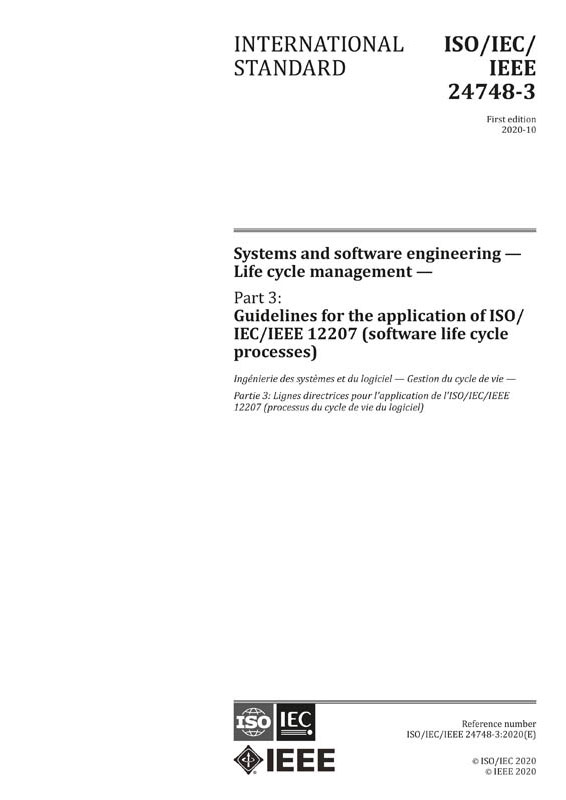ISO/IEC/IEEE 24748-3:2020
Systems and software engineering - Life cycle management - Part 3: Guidelines for the application of ISO/IEC/IEEE 12207 (software life cycle processes)
Ausgabedatum:
2020-10
Edition:
1.0
Sprache: EN - englisch
Seitenzahl: 66 VDE-Artnr.: 249289
This document is a guideline for the application of ISO/IEC/IEEE 12207:2017. This document establishes guidance to implement a common framework for software life cycle processes, with well-defined terminology, that can be referenced by the software industry. This document provides guidance on defining, controlling, and improving software life cycle processes within an organization or a project. This document recommends methods and approaches suitable for a variety of life cycle models. The guidance emphasizes the importance of establishing a strategy, planning, and the involvement of stakeholders, with the ultimate goal of achieving customer satisfaction.
This document applies to the acquisition, supply, design and development, transition, operation, maintenance, and disposal (whether performed internally or externally to an organization) of software systems, products, and services (including software as a service (SaaS)), and the software portion of any system. Software includes the software portion of firmware. The guidance on processes, activities, and tasks in this document can also be applied during the acquisition of a system that contains software. The guidance in this document can also be used as a basis for selecting, establishing, and improving organizational environments, e.g., methods, procedures, techniques, tools, and trained personnel.
In the context of this document, there is a continuum of human-made systems from those that use little or no software to those in which software is the primary interest. It is rare to encounter a complex system without software, and all software systems require physical system components (hardware) to operate, either as part of the software system-of-interest (SoI) or as an enabling system or infrastructure. Thus, the choice of whether to apply this document for guidance to the software life cycle processes, or ISO/IEC/IEEE 24748-2, depends on the SoI. At a high level, both documents have the same life cycle process framework, but differ in guidance for activities and tasks to perform software engineering or systems engineering, respectively.
The processes and process groups in this document are identical in their purpose and outcomes with those in ISO/IEC/IEEE 12207:2017 and in ISO/IEC/IEEE 15288:2015, with one exception: the System/Software Requirements Definition process of ISO/IEC/IEEE 12207:2017 and this document has a different name from the System Requirements Definition process of ISO/IEC/IEEE 15288:2015.
Use of the guidance in this document is appropriate regardless of software system size or complexity or organizational size. The process outcomes from the ISO/IEC/IEEE 12207:2017 life cycle processes are meant to be generic and applicable to the engineering of any software system in any size organization.
This document does not prescribe nor detail a specific software life cycle model, development methodology, method, modelling approach, or technique and method. The variety of ways for implementing software (e.g., development of new code, integration of existing open source components and commercial products, or modifications to existing software, including transition to new platforms) make it impossible to detail specific procedures.
This document does not establish a management system or provide guidance on the use of any management system standard. However, it is intended to be compatible with the quality management system specified by ISO 9001, the service management system specified by ISO/IEC 20000-1, the IT asset management system specified by ISO/IEC 19770 (all parts), and the information security management system specified by ISO/IEC 27000.
Clause 6 provides guidance on aspects of purposes, outcomes, activities, and tasks in ISO/IEC/IEEE 12207:2017. However, this document does not repeat the detailed requirements and recommendations for purposes, outcomes, activities, and tasks for each life cycle process found in ISO/IEC/IEEE 12207:2017. Clause 6 also provides references to specialized standards that provide more detailed requirements and guidance for the various processes and information products (information items). This document does not detail information items (process inputs and outputs) in terms of name, format, explicit content and recording media.
NOTE ISO/IEC/IEEE 15289 addresses the content for life cycle process information items (documentation).


